Collectible card trading has always been an exciting and engaging hobby for enthusiasts. Over the years, I’ve come to appreciate the sense of community that evolves around card collecting and trading, as well as the thrill of discovering new and valuable cards. As a collector, you must stay informed about the market, trends, and values of your chosen cards to maximize your enjoyment and success.
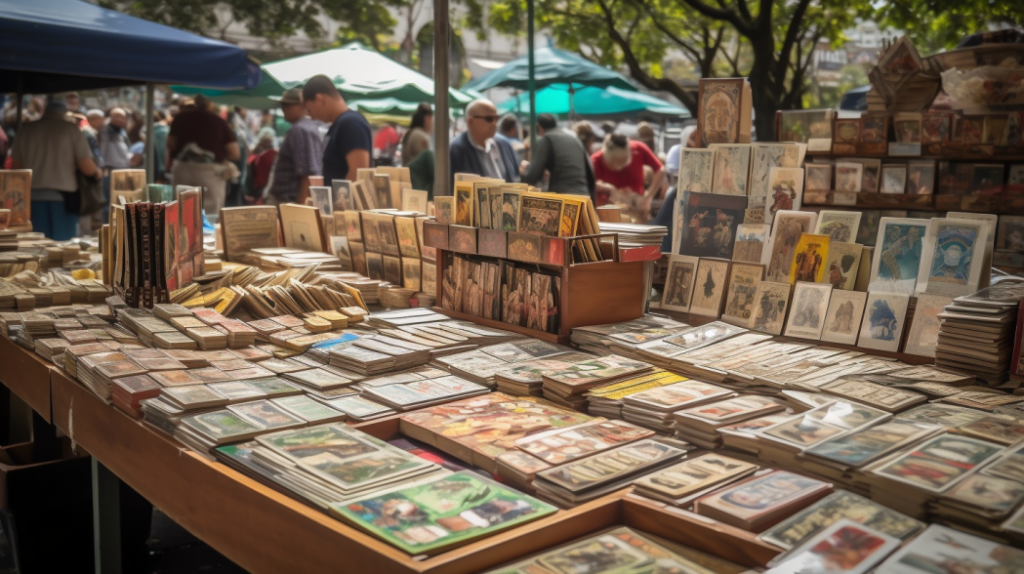
One essential aspect of card collecting is understanding the importance of condition, rarity, and demand when it comes to the value of trading cards. By familiarizing myself with the grading systems and learning how to carefully store and handle my cards, I’ve been able to maintain and enhance the value of my collection.
Of course, the true joy of card collecting comes from the connections and friendships formed with fellow collectors and traders. Through trading, I’ve been able to expand my collection while also learning from others’ experiences and insights. Embracing this supportive and knowledgeable community is a surefire way to thrive in the exciting world of collectible card trading. Whether you’re just starting or looking for ways to enhance your collection, the world of collectible card trading offers endless excitement and opportunity. Dive into the Collectible Card Hobby: A Comprehensive Guide for more tips and insights.
Understanding the Collectible Card Market
When I first started exploring the world of collectible card trading, I found that understanding the market was crucial to my success. In the collectible card industry, the value of a trading card is driven by supply and demand, just like any other market.
One of the essential factors in determining a card’s value is its rarity, whether it’s a rookie card from a player’s first year in the league or a limited edition serial-numbered card with a short print run. High demand for these rare cards can significantly impact their value, making them more desirable to collectors.
As a collector, I know that condition is also a critical factor in determining a card’s value. A well-maintained card can fetch a higher price than one with noticeable wear and tear. This is where grading comes into play, as professional grading companies can assess the condition of a card and assign a numerical grade to help establish its market value.
To keep track of the ever-changing market values for various trading cards, I always make use of comprehensive price guides like the PSA Price Guide. These resources provide an extensive database of trading card values, giving collectors like me a better understanding of the current market trends.
In my experience, making informed decisions in the collectible card market involves doing thorough research on the historic price and current market value of cards I’m interested in buying or selling. Websites like COMC, dedicated to selling collectibles including sports cards, can also help gauge the market and find desirable cards for my collection.
Ultimately, as a collector, I am aware that the collectible card market can be volatile and may fluctuate in value. By staying knowledgeable and up-to-date on trends and market demands, I can better navigate the industry and make the most informed decisions for my collection.
Acquiring Cards
Where to Buy
In my experience, there are various places to buy collectible cards, such as online platforms, local hobby shops, and auction sites. One popular online platform is eBay, where you can find cards from well-known brands like Topps and Upper Deck. It’s important to choose reliable and established online stores when purchasing cards. Comparing prices between different retailers can help you get the best deal available.
Aside from online platforms, I also enjoy visiting local hobby shops, where you can purchase retail boxes and blaster boxes containing a number of packs. These boxes can offer a more engaging experience, as you get to open packs and discover new cards. However, it’s crucial to know the difference between retail and blaster boxes, as they may contain different types of cards.
Auction sites can be another viable option for acquiring rare and valuable cards. Just remember to verify the card’s condition and legitimacy before placing a bid.
Types of Cards
In my card-collecting journey, I’ve come across a variety of card types, each with its own unique appeal:
- Rookie Cards: These are cards from a player’s first year in the league and are highly collectible. They often hold more value due to their limited availability and the potential for the player’s success.
- Serial or “Crash” Numbered Cards: These are short-printed cards that have a print run number stamped on them (e.g., 01/25). Their scarcity can make them more desirable to collectors.
- Complete Sets: A completed series of numbered regular cards, inserts, or hits from a particular product. Collecting sets can be a satisfying and challenging experience.
In summary, acquiring cards for your collection can be done through various methods, such as online platforms like eBay, local hobby shops, and auction sites, where you can find cards from top brands like Topps and Upper Deck. Understanding the different types of cards, such as rookie cards, serial numbered cards, and complete sets, can help you curate a collection that reflects your interests and passions.
Preserving and Storing Cards
As a collectible card enthusiast, I know that preserving and storing cards properly is essential to maintaining their condition and value. In this section, I’ll share some tips on card protection and storage solutions.
Card Protection
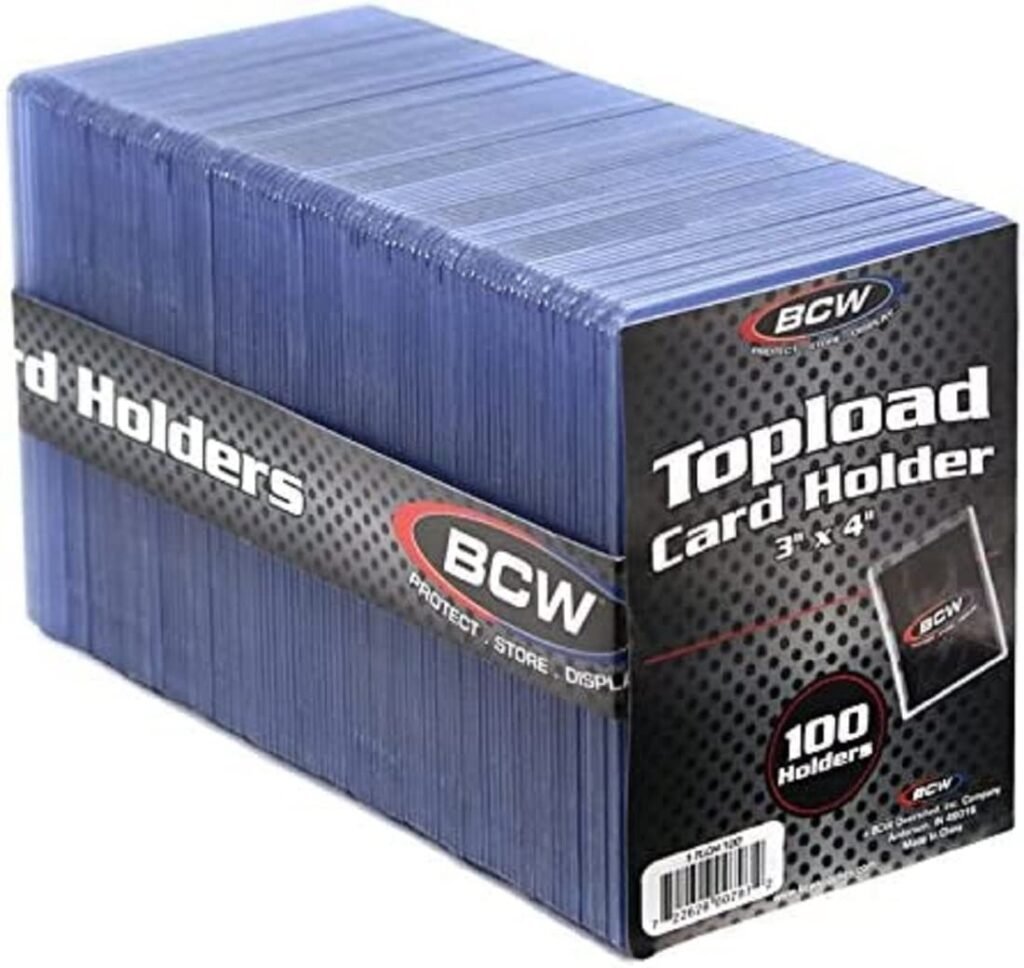

One of the key aspects of card preservation is providing proper protection. There are a few methods that I find effective for protecting my cards:
- Penny sleeves: These affordable, thin sleeves offer basic protection, although they may not prevent bending. I like to use them for short-term storage or when handling cards that aren’t too valuable.
- Card savers: These semi-rigid plastic holders offer better protection than penny sleeves. They keep my cards safe from bending, and I often use them when sending cards for grading or when storing more valuable cards in my collection.
- Toploaders: These durable, rigid plastic holders provide excellent protection for my cards, especially when combined with penny sleeves. They’re great for storing, displaying, or shipping individual cards.
- Binders: For keeping multiple cards organized, I turn to binders with card pages. They offer protection, easy access, and visibility for cards that I handle more frequently. However, I’m careful to choose acid-free pages to prevent any damage from long-term exposure.
Storage Solutions
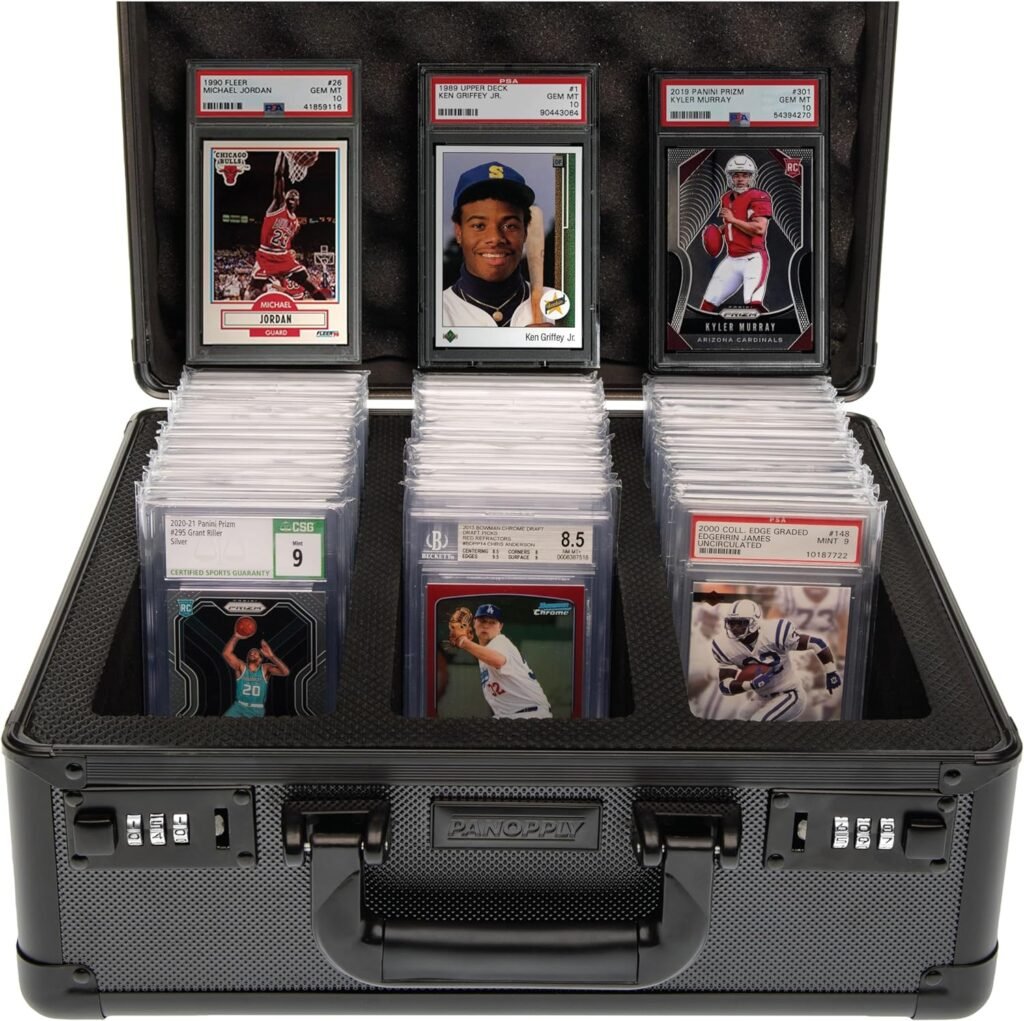
In addition to card protection, having the right storage solution is important for preserving my collection’s condition. Here are some storage options that work well for me:
- Card storage boxes: These corrugated cardboard boxes come in various sizes (100-count, 200-count, 500-count, etc.) and provide a practical way to organize and store cards. I make sure to keep these storage boxes in a dry, cool place and out of direct sunlight to prevent fading and damage.
- Slab cases: For my graded cards, I use slab cases, which are specifically designed to protect and display these valuable items. They come with handles, straps, or wheels, depending on my needs and preferences.
- High-quality cabinets or shelves: For cards that I want to display, I consider investing in high-quality cabinets or shelves that offer both protection and an attractive way to showcase the collection. Just remember to keep them away from direct sunlight or areas with high humidity.
By following these card protection and storage tips, I’m confident that I can maintain the condition of my collectible card collection and preserve its value for years to come.
Collectible Card Grading and Authenticity
As a card collector, I know how important card grading and authenticity is in the world of collectible card trading. Card grading is the process of submitting a trading card to a third-party service, such as PSA, to be inspected for condition and authenticity. These grading companies assess various aspects of the card, such as corners, surface, edges, and centering, and then assign a grade on a scale, typically PSA’s 1-10 grading scale.
I personally find that a card’s corners and surface are often the primary factors that affect its grade. Corners should be sharp and well-defined, while the surface should be free of any noticeable scratches, dents, or imperfections. Additionally, proper centering and well-preserved edges contribute to a card’s overall grade.
One of the top grading service providers in the industry is PSA, which has its own grading scale ranging from PSA 1 – Poor to PSA Gem Mint 10, with a PSA Gem Mint 10 signifying an almost perfect card. Their authentication process ensures that the card is genuine and has not been tampered with or altered.
Grading is an essential aspect of card collecting because it provides a standardized and widely accepted method of evaluating a card’s condition. This allows collectors to confidently trade, buy, and sell cards, knowing that they are getting a card authenticated by a reputable grading company like PSA. Getting cards graded can also protect and potentially enhance their value, especially for those in excellent condition.
For collectors looking to make sound investments in the graded card market, understanding all the nuances of card grading is essential. With the knowledge I have gained from my experience in graded card collecting, I highly recommend reviewing the Beginner’s Guide to Graded Card Investing for valuable insights, tips, and strategies to help you confidently navigate the market. Remember, a well-informed collector is more likely to make smart choices and ultimately succeed in the world of collectible card trading.
Investing in Cards
As a card collector, it’s important to strategically invest in valuable cards in the long run. When investing in cards, there are some key aspects that I keep in mind to ensure I maximize my return on investment.
In my experience, evaluating the value of a card is essential. This depends on factors like its rarity, condition, and demand among card investors. Before buying a card, I always assess its potential value in the future and not just its current worth.
Rookie cards have always been my favorite type of investment. These cards showcase a player’s first appearance in their career and tend to appreciate in value if the athlete achieves success over time. Popular rookies to invest in are usually those picked early in the draft or those with significant potential to be future stars.
Additionally, I pay attention to parallel cards. These special cards feature alternate variations of a base card with additional embellishments like different colors, patterns, or even autographs. Parallel cards, being rare, can be valuable investments if chosen wisely.
Through my tenure as a card collector, I have developed a keen interest in discovering different brands associated with card collecting. Some popular brands I follow are Topps, Panini, and Upper Deck. When investing in a card, I choose brands that carry prestige and are sought-after by other card investors to increase my chances of better returns on investment.
Ultimately, successful card investing involves staying updated on market trends, carefully selecting valuable cards, and being patient for their values to appreciate. Combining knowledge and a clear vision of the market helps me make informed choices and enjoy this lucrative hobby.
Engagement with the Collecting Community

As a collector, I find that engaging with other collectors in the card trading community is essential to get the most out of this hobby. Not only does it make the experience more fun, but it also provides valuable insight, resources, and connections. It’s essential to identify the best ways to engage with the trading card community and develop great relationships with other collectors.
My favorite way to connect with other collectors is through social media platforms like Twitter, where I can follow other collectors and easily engage in conversations. I’ve found that social media channels are an excellent platform for discussing my favorite players, sharing finds, and learning about rare cards or market trends.
Another essential aspect of engagement is joining online communities like Reddit and Discord, where collectors can communicate and share knowledge. By participating in these virtual spaces, I stay informed on the latest news, product releases, and checklists of tradeable cards, and even gain inspiration for customizing my collection.
Lastly, attending events like collector meet-ups, conventions, and card signing appearances by our favorite players can help solidify connections and put faces to the names. By meeting other collectors in person at such events, we can exchange cards, swap stories, and share personal experiences, resulting in a more enriching and enjoyable card collecting journey.
Engaging with fellow collectors not only creates fun social connections, but it will also help me navigate the exciting world of collectible card trading and grow my collection in a meaningful way. Throughout my experience, I’ve discovered that the value of engagement and developing relationships with other collectors is just as important as the cards themselves.
Specific Collectible Cards
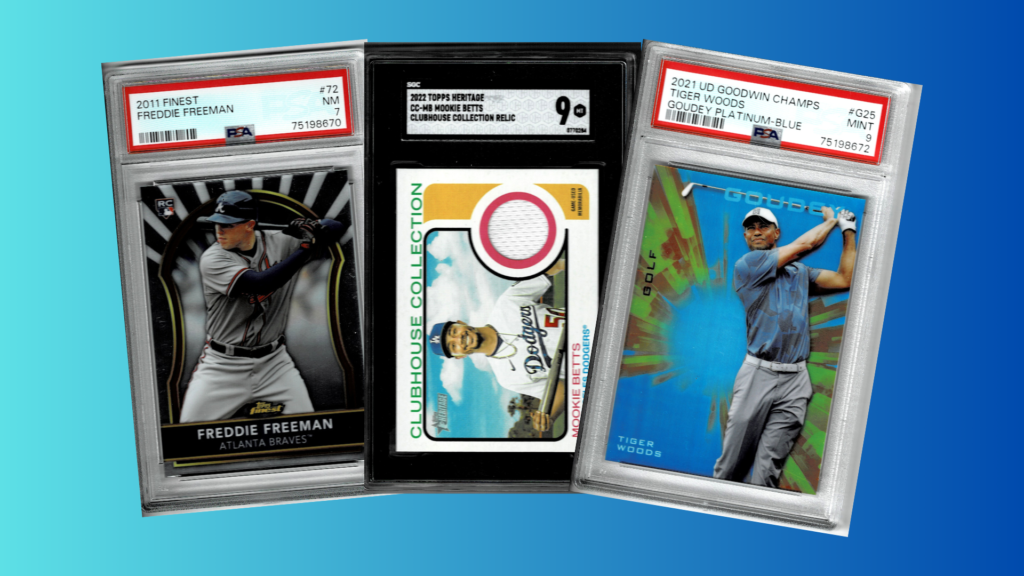
As a collector, I like to focus on specific types of collectible cards, such as sports cards and Pokémon cards. In this section, I will share my knowledge and tips for collecting these types of cards.
Sports Cards
Sports cards capture the excitement and achievements of our favorite athletes. It is important to learn about the different types of sports cards, such as rookie cards and autographed cards.
Rookie cards are highly sought after because they are from a player’s first year in the league. For example, a Michael Jordan rookie card can fetch a high price due to its rarity and the legendary status of the athlete. Some notable rookie cards to watch out for are Wander Franco in baseball and Michael Jordan in basketball.
To ensure the authenticity and value of autographed cards, always look for cards that come with a Certificate of Authenticity (COA) from reputable sources like Topps, Upper Deck, or Panini. Signed cards from stars like Michael Jordan can be a valuable addition to any collection.
When collecting sports cards, keep in mind the following tips:
- Pay attention to the card’s condition, as any damage or wear can significantly affect its value.
- Consider investing in a card storage and display system, like binders with card sleeves, to protect your collection.
- Research the market and compare prices to ensure you are making informed decisions when buying or selling cards.
Pokémon Cards
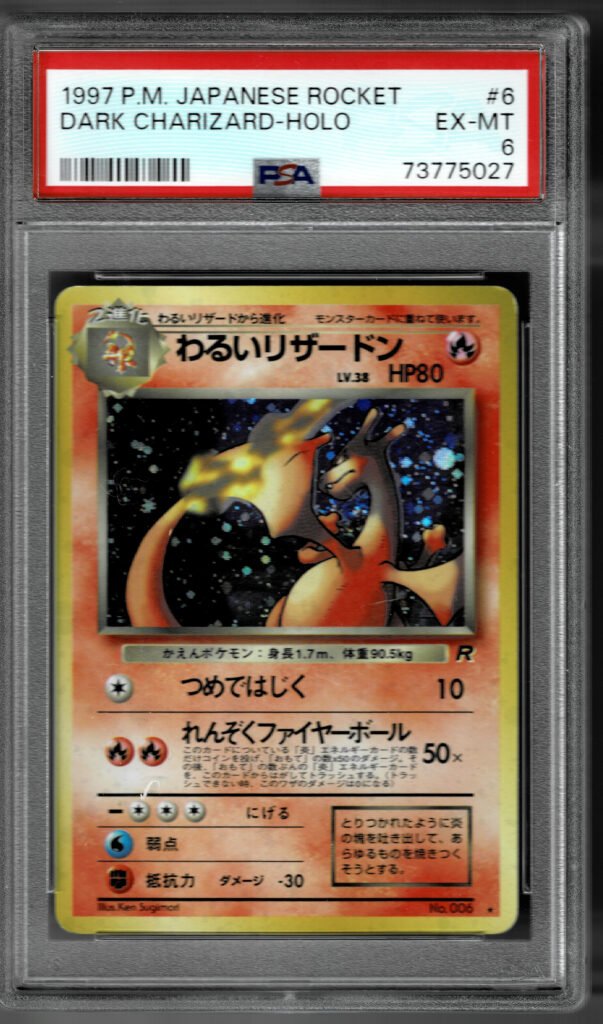
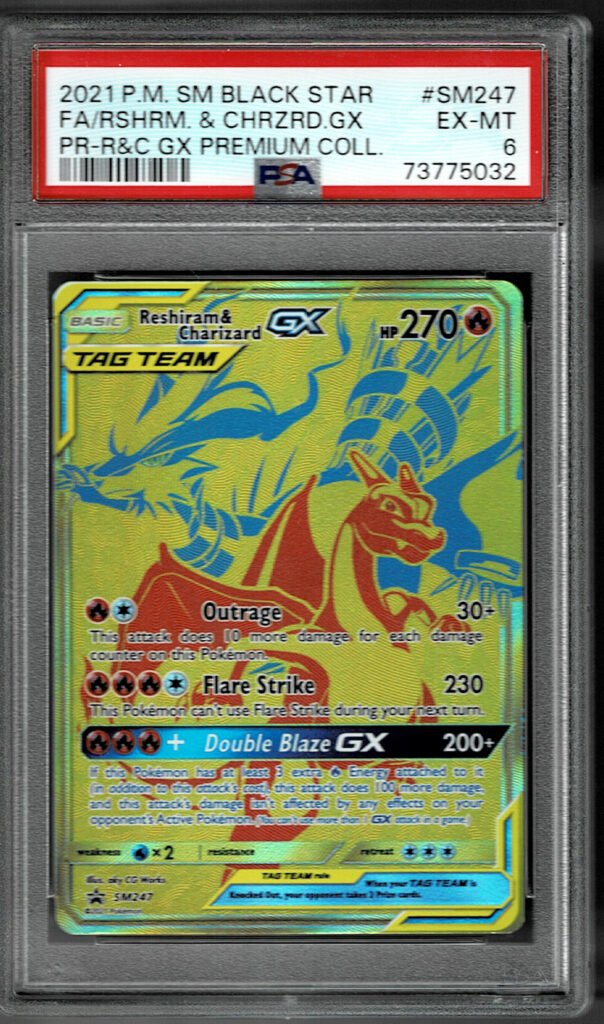
Pokémon cards have been a staple in the collectible card game world since the 1990s. Some of the most valuable cards, like 1st edition Pokémon cards, are highly sought after and can fetch high prices. Here are my tips and recommendations for collecting Pokémon cards:
- 1st edition Pokémon cards, especially those from the early sets (Base Set, Jungle, and Fossil), hold significant value due to their rarity and the nostalgia they evoke. Look for cards with the “1st Edition” stamp on the bottom left corner.
- Holofoil cards, or cards with a shiny, reflective surface, are more valuable than their non-holo counterparts.
- Keep your cards in protective sleeves and binders to maintain their condition and value.
- Stay up-to-date with new releases and expansions, as they can introduce valuable cards and new fan-favorite Pokémon.
Remember to always have fun and enjoy the process of collecting. With dedication, research, and a passion for the hobby, you will find success and satisfaction in your collectible card adventure.
Frequently Asked Questions

What are the most profitable trading cards to collect?
There is no definitive answer to which trading cards are the most profitable, as values fluctuate based on various factors such as popularity and market trends. My advice would be to keep an eye on news and current events related to collectible cards, as well as player or series popularity to get the best insights into profitable options.
How can beginners start collecting sports cards?
For beginners interested in sports card collecting, I recommend starting by researching your favorite sports, teams, or players and determining which card series or sets are available. Next, create a budget and attend card shows, or shop online on credible websites or platforms. It’s also essential to learn how to properly store and protect your cards to preserve their value.
How to identify rare and valuable trading cards?
Identifying rare and valuable trading cards can take some practice. As a general rule, look for specific factors such as limited print numbers, autographs, or special edition releases. Additionally, the condition of the card plays a major role in its value, so clean corners and lack of creases are desirable. Familiarize yourself with sports card price guides and, if necessary, consult with experienced collectors or professionals for authentication and grading.
What are useful tools or websites for card collecting?
Some useful tools and websites to assist with card collecting include price guides, card grading services like PSA, and forums or social media groups where collectors discuss their findings and share knowledge. Online auction sites and card-specific marketplaces are also helpful for buying, selling, and researching values of collectible cards.
Are trading cards a worthwhile investment?
Trading cards as an investment can be worthwhile for some, but it’s essential to approach it with caution and knowledge. The collectible card market can be volatile, with values influenced by many factors. To improve the chances of success in this investment, develop an understanding of market trends and be prepared to invest both time and money in acquiring valuable cards and properly storing them.
What is the most effective method to organize a card collection?
Organizing your card collection ultimately depends on your personal preferences. Storage options to consider include binders with protective sleeves, individual card sleeves, top-loaders, or specially designed boxes. It’s crucial to protect your cards from dirt, sunlight, and excessive handling. To further simplify organization, you may sort your collection by sport, team, player, set, or even by card condition.

Hi there! I’m Felix Gonzalez and I am the owner of Card Collecting Insider, and I’m thrilled to welcome you to my site! With our tagline “Uncover the Art of Collecting, One Card at a Time,” I’m here to provide you with expert insights, valuable resources, and the latest trends in the world of card collecting. Whether you’re a seasoned collector or just starting out, I’m dedicated to helping you discover hidden gems and sharing insider tips to elevate your collection. So join me on this exciting journey, as I dive deep into the captivating realm of card collecting. Let’s unlock the true beauty of these collectible treasures together!

